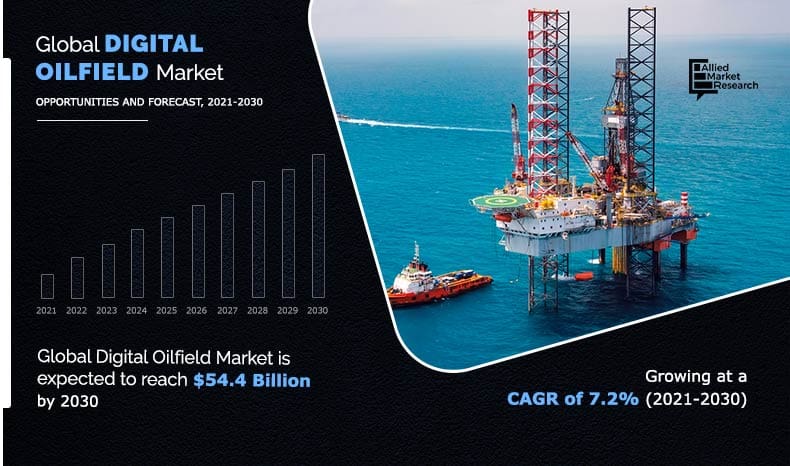The digital oilfield is the most exciting opportunity for oil and gas companies to run operations. It is much more than a futuristic technology solution. The developments in key disruptive technologies such as big data, artificial intelligence (AI), and the Internet of Things (IoT) have made it easier to bring automation and AI-driven functionality to the mining industry.
For years, oil and gas companies have been dependent on hi-tech, consumer-driven industries to try and test the viability of the latest technological developments and apply it to the most innovative idea of digital oilfields. The human labor-intensive field found new opportunities in cloud, mobility, and machine learning. The term digital oilfield refers to a technology-based solution that involves the use of software systems and advanced data analysis to improve oil recovery from the seabed. The software part simulates the operation of the oil & gas field using predictive analysis and employing workflows from wellbores, surface facilities, and reservoirs.
According to Allied Market Research, the global digital oilfield market is expected to reach $54.4 billion by 2030, growing at a CAGR of 7.2 percent from 2021 to 2030. The rise in investments toward digital technologies in the oil and gas industry and the surge in the need for production optimization from existing wells drive market growth.
Digital oilfield streamlines the decision-making process by using intelligently filtering data and it helps in the deployment of both human and machine resources. In addition, the technology helps in hydrocarbon production optimization, environmental protection, overall safety and reduces wastage of valuable resources.
Recently, Weatherford International plc., a leading wellbore and production solution company was awarded a three-year digital oilfield contract from Kuwait Oil Company (KOC) which is one of the prime market players in the upstream industry. The contract states support for KOC’s digital transformation strategy and deploying its Integrated Enterprise Excellence Platform across KOC. Moreover, the contract includes real-time monitoring, instrumentation, production optimization and assurance of wells to allow KOC to optimize its production and other plans. The project involves heavy oil wells analysis, well design, model tuning, asset optimization, integration with several E&P applications, and surveillance & forecasting. This will enable KOS to improve its personnel efficiency, maximize uptime, and improve overall production. The technology will include the use of artificial intelligence and machine learning to help prioritize production-uplift opportunities, detect and predict failure, and plan and execute workovers.
One of the leading providers of IoT-enabled automation software, Lavoro Technologies, declared to launch Agora Marketplace with a partnership with Agora IoT. This deal will enable Lavoro to aid several oil and gas companies to get quick and measurable ROI by optimizing production and will allow them to remotely monitor and manage their assets. The companies declared to launch three applications through Agora Marketplace including Lavoro Plunger, Lavoro Tank, and Lavoro Ticket. These technologies will enable real-time remote visibility, real-time analysis, and control of field operations. The applications are easy to integrate with existing equipment and can be run through menu-driven configuration. In addition, the data can be shared anywhere if necessary and it eliminates inefficiencies in the day-to-day operations.
Such cutting-edge technologies have helped achieve the dream of the digital oilfield. Oil and gas companies demand the scalability and ease of innovation that cloud computing can offer. While the security of cloud computing was a cause of concern for years, its pros outweigh the cons and the fear of ownership can no longer be justified. Moreover, there is no other technology that offers scalability as cloud computing does. It offers the oil and gas industry a new tool to bring innovation in on-premise solutions and production planning. What’s more, it can be integrated without the need for large capital expenditure.
Apart from cloud computing, mobile platforms have enabled us to come closer to the digital oilfield. The mobility revolution in the oil and gas industry will bring ease to operations. Moreover, real-time monitoring of wells enables prioritizing the locations and smart mobility apps help to handle the complexities of managing planned and unplanned events including environmental compliance inspections. Although cloud and mobility improve computation and generation of data, big data analytics addresses the process. Big data analytics offered a way to deal with the existing colossal amount of data and offer actionable, trustworthy intelligence for better decision-making. For years, oil and gas companies suffered from inaccurate data and a lack of ways to improve decision-making. However, big data analytics offers trustworthy information and ownership over the data.
For years, the digital oilfield was a dream. However, as we move into the age of data-driven technologies, multiple tools are now at our disposal to improve operations in the oil and gas industry. Companies are slowly realizing the potential of these technologies leveraging them to make smart decisions and choosing which technology to use to move forward. The developments in these technologies will certainly help achieve the true objective of a digital oilfield.






